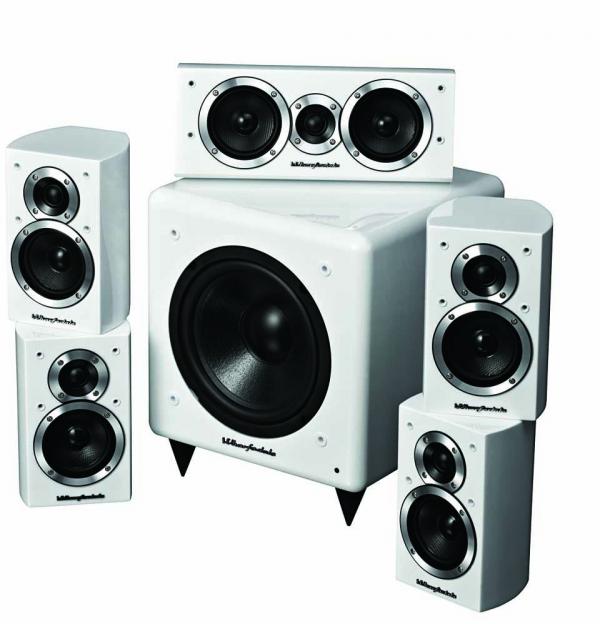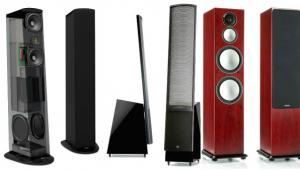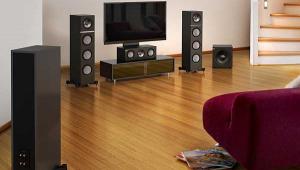Sound Choices: How to Pick the Best Speakers for You

Virtually all music recordings and film soundtracks are intended by their creators to be heard over speakers. There’s good reason for that: Speakers yield the most natural tone and the most accurate spatial presentation — qualities that are difficult or impossible to match via any sort of headphone listening. But what kind of speakers should you buy?
The bewildering range of sizes, types, topologies, and technologies can easily overwhelm any of us, so let’s break it down into a few logical categories.
Sub/Satisfaction
A stereo speaker system may comprise a left/right pair ranging from Kleenex box-size to fridge-size, or a trio consisting of a left/right satellite speaker pair plus a subwoofer. In the first case, both speakers reproduce the full range of sound from deepest bass to tip-top treble to the best of their ability. In the second, the pair of left/right satellite speakers handles most of the 10 or so octaves of humanly perceivable sound, while the subwoofer handles the lowest two or three, usually directed to it by crossover circuitry in an A/V receiver or processor (though many subs have such facilities onboard as well). Satellites can also go by the handle “bookshelf ” speakers, though these only rarely live on actual shelving, bookish or otherwise; more often they are placed on dedicated speaker stands some 20 to 30 inches tall.
An advantage to sub/sat systems is that you can assemble a full-range layout without sacrificing quite so much floorspace. The sub can also be placed in a location that exploits room acoustics to best effect for bass extension, while the satellites get positioned for optimal stereo imaging. A disadvantage with sub/sat systems is that you have to worry about the sub-to-satellite blend, which calls for judicious tweaking at setup time to yield the best, most musical transition.
Towers of Power
Tower speakers are floor-standing models that are almost always designed to reproduce full-range stereo music without a subwoofer, though few but the largest and most costly can match the bass extension and power of a big sub. Consequently, many tower-based speaker systems will still add a subwoofer for that last half-octave of deepest bass and maximum low-frequency impact on movie sound. (A number of “Power Tower” designs from makers like GoldenEar Technology and Definitive Technology simplify things by building powered subwoofers right into the speaker cabinets.) There are compact towers as slim as plant stands and barely waist-high, and hulking behemoths as large as — well, you don’t want to know. (Or do you?)
Speakers, Speakers on the Wall
Small or large, satellite or tower, most speakers are generally engineered to sound best when placed free-standing well out into the room. If stuffed hard against the wall, they will not produce their best sound due to the acoustically unhappy proximity of a large, reflective surface.
On-wall speakers, on the other hand, are designed precisely for that location. These are shallow-box designs that can be easily wall-mounted — often simply hung like a picture frame — and are usually satellite types intended for integration with a conventionally free-standing subwoofer. Many are styled to flank wall-mounted flat-screen TVs, and the best examples are acoustically engineered to mitigate the worst sonic reflections.
In-wall, or “architectural,” speakers work similarly, but they require cutouts in the actual plaster or wall-board surface and are usually open in back, exploiting the wall cavity as a sort of speaker enclosure. In-wall systems will often include a subwoofer, too, either a conventionally free-standing one or, more rarely, an in-wall model. Ceiling speakers are simply in-walls designed for in-ceiling installation. Ceiling models are popular in décor-first domiciles, but most A/V-philes (like me) will advise that you’re best off confining them to casual, “background” spaces like kitchens or hallways or — in a pinch — surround-channel applications.
Sounds, Bar-None
We come now to the ever-more-popular soundbar, a variant that within itself contains multitudes. Soundbars combine multiple speakers into a single cabinet, substituting for more elaborate (and better-performing) but probably less spouse-conciliating discrete speaker systems. On the plus side, they can lure many listeners to the serious-sound side who might otherwise eschew high-quality audio altogether.
Soundbars can be divided technically among passive models, which connect to a receiver’s or amplifier’s speaker outputs in the usual way, and active designs, which build dedicated power amplifiers for some or all channels right into the cabinet and connect to a receiver’s or preamp/processor’s line-level outputs.
The simplest passive-soundbar variant species places just the three front channels — left, center, and right — into a single slim, horizontal cabinet styled to wall-mount elegantly beneath a flat-panel TV. Such models can be combined with conventional, freestanding surround speakers (wall-mounted or otherwise) and a subwoofer. There are also five-channel passive soundbars, whose surround-channel drivers direct sound at a variety of clever angles to exploit reflections from ceiling or walls. This lets them create, with more or less success, the sense of space that actual surround speakers contribute in conventional multicabinet systems. (Usually less, if we’re going to be completely frank.)
Active soundbars also come in both persuasions. But here, the built-in amplification provides an opportunity for audio DSP (digital signal processing) to work some serious magic. The best active/DSP five-channel examples can conjure true spaciousness and “behind you” surround effects. But even the best of them rarely equal the ambient-surround and effects performance of a competent free-standing multispeaker system.
Polar Opposites
The overwhelming majority of speakers, whether tower, bookshelf, front, center, or surround, are forward-radiating monopole designs. These spread sound more or less evenly in the forward direction only. But there are two other sorts: bipolar and dipolar. A bipole speaker, which places two monopoles back to back (wired in-phase so that their drivers move in and out together in sync) radiates sound more or less in all directions covering 360°. A dipole speaker is physically identical, but its front- and rear-facing driver sets are connected out of phase: When the front woofer and tweeter are pulsing outward, their opposite numbers move in, and vice versa, in a “push-pull” arrangement. Consequently, a dipole radiates sound forward and rearward but, due to cancellations, in a roughly figure-8 pattern with much less to either side. Most bipolar and dipolar speakers are surround-channel-specific designs meant to be located toward the rear of the listening area, where their ability to induce more evenly spread reflections from walls and the ceiling can enhance the naturalness of film-sound spatial effects and the ambience of surround music.
That said, a number of electrostatic and planar-magnetic main-channel speaker designs are by nature dipolar. (A large-area flat membrane vibrates, radiating sound both forward and rearward, with cancellations inducing a broad null to the sides.) Electrostatic and planarmagnetic speakers, which are made by companies like MartinLogan and Magnepan, are loved by audiophiles for their deep, spacious sound on natural-stereo music recordings. Large, full-range bipolar speakers that use conventional cone and dome drivers can also be had from companies like Definitive Technology. These, too, can yield extra-spacious sound.
















































